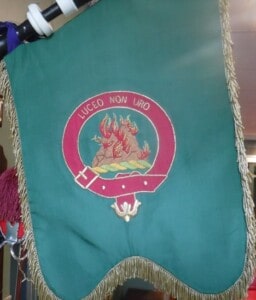Heraldry: Motto: Luceo Non Uro: (Latin) I Shine, Not Burn Reverse: A fire gules on a wreath of vert and or encircled in a belt and buckle gules of the second on a field of Vert. Obverse: 48th Highlanders, Diamond Badge, proper, on a field of azure Culture: Scottish
Service: Commanding Officer 48th Highlanders 1944-1945. Killed in Action on April 12, 1945 (Wilp, Netherlands)
Pipe Banners are a decorative Scottish flag that is tied to the bass drone of a set of bagpipes. These flags are carried by Pipers on important occasions and parades. They have a long tradition of use by Highland Regiments and Clan Chiefs. Each Banner is hand embroidered on heavy silk damask and fringed in gold bullion thread; an expense normally borne by the Officer whose family crest is seen on the reverse side.
In the 48th Highlanders of Canada it is the custom that all Field Officers (Company Commander, usually a Major) or higher have a Pipe Banner that is carried by their Piper on parade. It is tied by ribbons to the base drone of a set of bagpipes. On the obverse side the Regimental Badge is displayed, normally on a field of Royal Blue. On the reverse side the personal arms, shield, helm, wreath mantling, crest, and motto as well as initials of the Officer is displayed on a field colour of that Officer’s choice. When not on parade Pipe Banners are hung in the Officers’ Mess.
On parade, the Pipe Major carries “The Regimental Banner” which displays on each side the Sovereign’s and Regimental Colours. The second-in-command of the Pipe Band carries the Commanding Officer’s Banner on parade. The junior Piper on parade carries the banner of the Regiment’s first Commanding Officer, Lt-Col J.I. Davidson, VD.

